Cheese Flavor Wheelby Pat Polowsky
Click the color wedge to zoom-in. Click the text to learn more about that attribute.
Your browser does not support flexbox!
Please view this demo with a modern browser.
Made using d3.js. Code inspiration from Mike Bostock and Jason Davies.
Download a pdf copy.
Grassy
Aroma associated with fresh-cut grass. Reminiscent of a pasture or green field. Often times just called by the general term "green".
- Cheese from grass-fed cows
- Secondary lipid oxidation products
Grassy aroma is usually attributed to aldehyde compounds such as geraniol or hexanal. These compounds usually come about through the secondary oxidation of lipids.

Hexanal - an aldehyde
Herbal
Aroma associated with fresh herbs. Encompassing general herbs and spices.
- Cheese with added herbs (duh)
- Some secondary lipid oxidation products
- Reblochon in some cases
Herbal aromas and flavors come from a large number of compounds and their combinations. Structurally aromatic compounds, esters, acids, aldehydes, and combinations thereof makeup a vast amount of the resultant aromas in herbs.
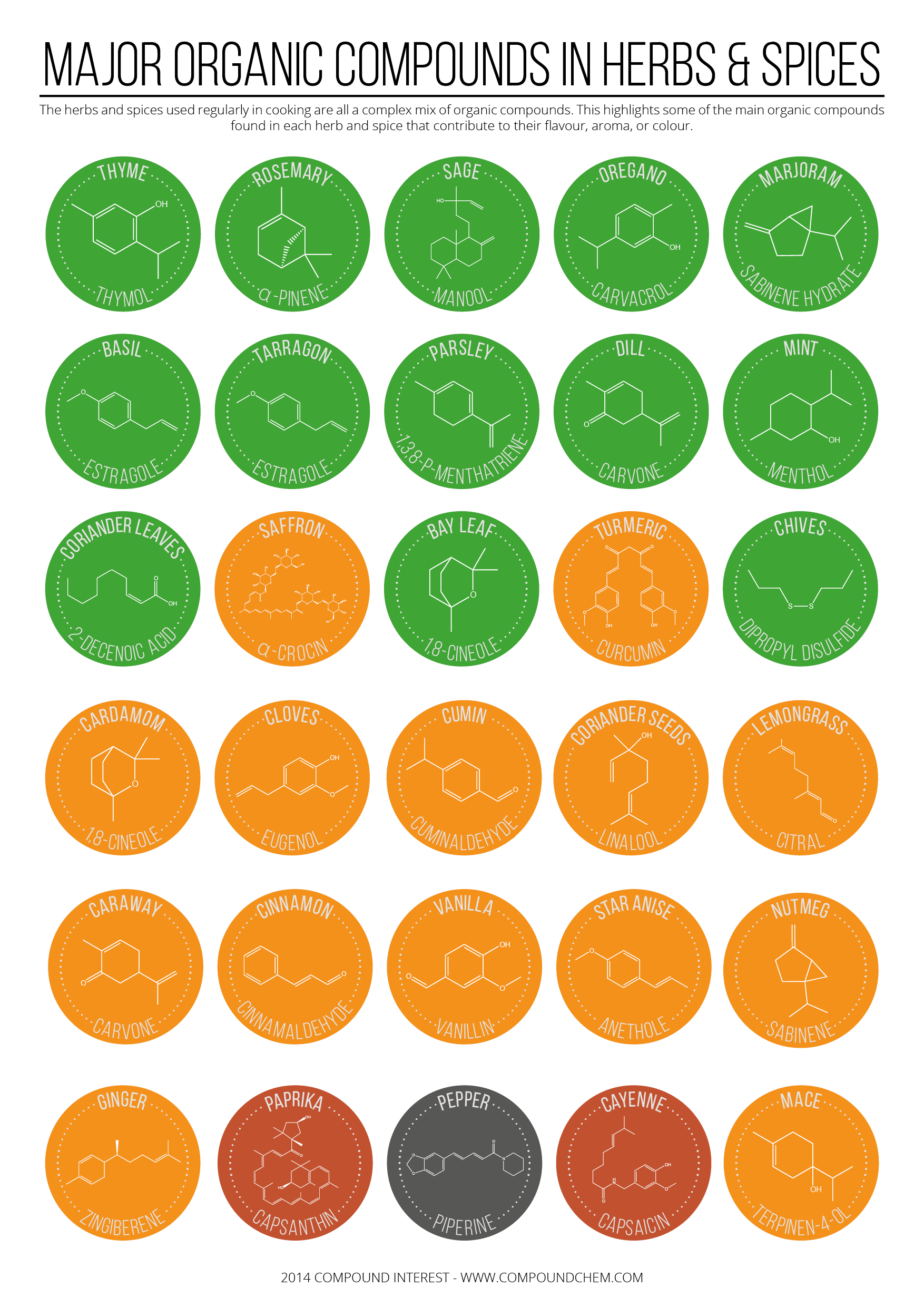
An example of various aroma compounds in herbs
Acetylaldehyde
Aroma associated with a "green apple" aroma. Often elicits a puckering sensation in the mouth.
- Fresh cheeses
- Fresh ricotta
- Fresh feta
- Kefalotyri
This compound is often generated by microbial activity, such as the lactic acid bacteria cultures used in cheesemaking. Examples include:
- S. thermophilus
- L. case
- S. diacetylactis

Acetaldehyde
Fruity Ester
Aroma concerning fruity aromas and flavors in cheese. Similar to pineapple, strawberry, and other fruits. Sometimes described as generic "fruity breakfast cereal"-type aroma.
- Many aged italian cheeses
- Many fresh cheeses as well
- Sarvecchio
- Parmasan
- Fresh chevre
Fruity aroma, much like many of the other complex aroma types in cheese, come from a variety of compounds. In many cases, esters are generated from enzymatic activity in cheese resulting from cultures or endogenous compounds in the milk. This class of compoudns are formed by the reaction of an acid with an alcohol compound, therefor ester formation could happen spontaneously without culture activity. For cheddar, high amounts of fruity aroma is considered a defect by professional graders.

Examples of common esters found in fruit
Rosy
Aroma associated with roses or other flowers.
- Some aged cheddars
- Some ages dutch-style cheeses
Rosy/floral aroma in one study was attributed to phenethyl alcohols, and the related esters and aldehydes.

2-phenylethanol - an example of a rose aroma compound
Piney
Aroma associated pine trees. Reminiscent of rosemary or other resinous herbs.
- Uhhh...I'm at a loss here
Related to herby aromas, piney aromas are usually attributed to terpene compounds such as geraniol or prenol. The mechanism through which these compounds are formed in cheese is not yet fully understood.

Geraniol - a monoterpene compound
Onion/Garlic
Aroma associated with members of the alium family: garlic, onion, etc.
- Defect carried over from the milk
When a cow's diet consists of high amounts of aliums, the main aromatic components of those foods can carry over to the milk and then into the final cheese. The compounds responsible for these aromas start their life as sulfur-containing amino acids, like cysteine. Various enzymatic activity within the vegetables create volatile aromatic compounds such as thiosulfinates.

Generic structure of a thiosulfinate
Unclean
Generic term describing the presence of a flavor/aroma that doesn't belong.
- N/A
N/A
Nutty
Aroma associated with generic nuts. This term is hard to define due to the wide variety of nuts and their associated flavors, some of which differ greatly.
- Swiss cheeses
- Aged cheddar cheeses
In the case of swiss cheese, the nutty aroma comes about from propionic acid production due to Propionibacterium freudenreichii subsp. shermanii. Nutty notes from cheddar are a little more complicated.

Propionic acid
Mushroomy
Aroma associated with fresh mushrooms. Umami-like meaty aroma.
- White mold cheeses
- Brie
- Some camemberts
Unlike many aromas in cheese, this one can be attributed to just about one key compound, mushroom alcohol. This compound comes about through the metabolism of the white mold on the exterior of the cheese.

1-Octen-3-ol - the so-called "mushroom alcohol"
Fresh
Another generic term much like "clean". Usually used for fresh cheeses.
- N/A
N/A
Milky
Aroma/flavor associated with fresh milk or milk-fat. Reminiscent of cream or whole milk.
- Fresh cheeses
- Mascrapone
- Queso Panela
- Gouda
- Many more...
Milky aroma is usually attributed to lactone compounds. These compounds come about through reactions of the fat in milk. See this study for potential mechanisms in gouda cheese.
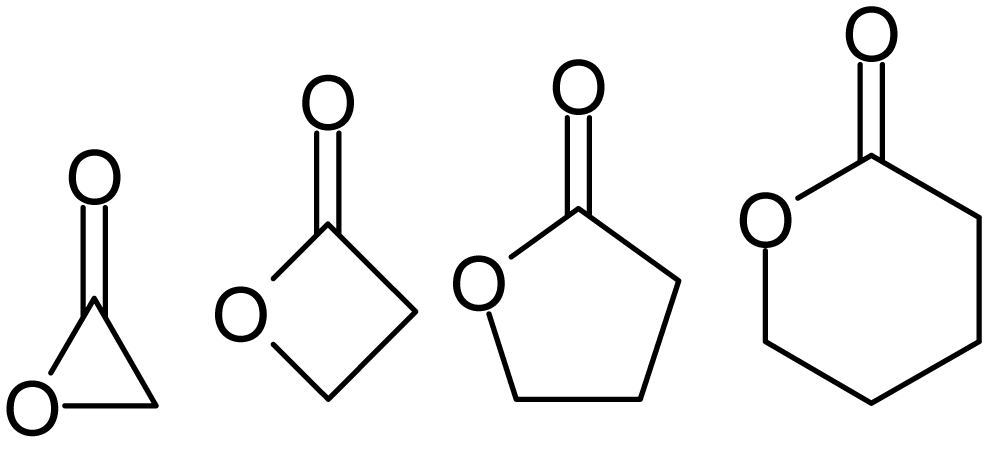
General structure of lactones
Buttery
Aroma associated with butter. Reminiscent of microwave popcorn.
- Many cheeses
- Jarlsberg
- Havarti
Buttery aroma comes from the compound diacetyl. Usually comes about from microbial activity or breakdown of compounds in cheese.

Diacetyl - buttery goodness
Sweet
Aroma associated fresh milk. Not the best term since it is so poorly defined.
- Ehhh...
N/A
Stale
Aroma associated with old milk.
- Old, poorly packaged cheeses
N/A
Sour
In this case, sour is referring to sour milk.
- Cheese made with sour milk
Usually comes about from microbes producing various types of acids.
Cooked
Aroma associated with cooked milk. One of those terms that is very difficult to describe.
- Cheeses with excessive browning
- Cheeses made from over-cooked milk
Cooked notes from cheese are usually due to browning reactions in the cheese. Maillard browning or other type of non-thermal browning reactions.

General outline of Maillard browning reaction scheme
Burnt
Caramel
Similar to cooked and burnt, I'll try to add more information one day.
- N/A
N/A
Cowy
Aroma associated with cows, barns, general dirty animal.
- Tilston point
- Some farmhouse cheddars
Cowy/barny is thought to be casued by cresol-type compounds. This aroma's complexity makes it hard to single out specific compounds. The exact mechanism is also hard to fully elucidate, but it is most likely microbially related.

p-Cresol
Goaty
Aroma associated with goats. Literally smells like goats.
- Goat's milk cheeses
Goaty aroma can usually be atrributed to specific fatty acids that are found in high concentration in goat milk.

Caprylic acid - a medium-chain fatty acid
Sheepy
Aroma associated with sheep.
- Cheese made from sheep's milk
- Manchego
Similar to goaty aroma. Fatty acid profile seems to be part of the sheepy aroma as well as other compounds. More research needs to be done to identify the root cause.
Horse
Aroma associated with a horse blanket. Reminiscent of a generic animalic mustiness.
- Musty cheeses
- Unclean cheese
N/A
Catty
Aroma associated with cat urine. Very strong and reminiscent of a sulfur-like aroma.
- Sulfury cheeses
Catty aroma is often lumped in with sulfur aroma due to similar chemistry of causitive compounds. A compound know as "cat ketone" is thought to be a cause of catty aroma.
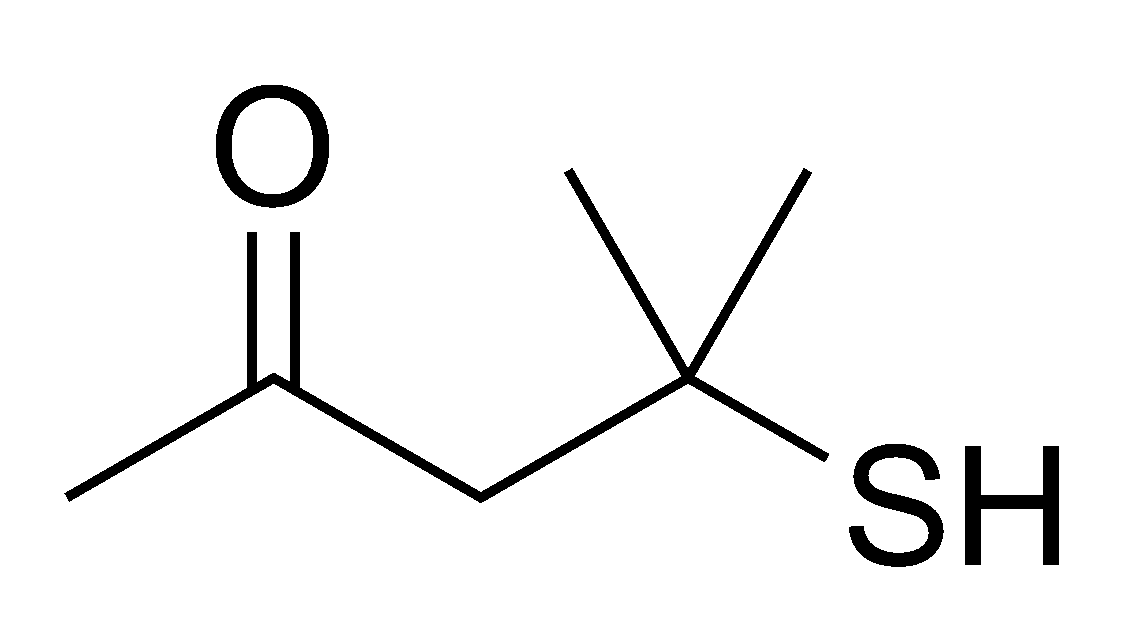
4-mercapto-4-methylpentan-2-one - "cat ketone"
Sweat
Aroma associated with sweat or body odor. The term sweat is often used interchangeably with "cheesy" when describing the aroma in other foods.
- Smear cheeses
Sweat aroma is usually attributed to wide-range of compounds. One such compound is isovaleric acid. Found in sweat and often described as having a "vomit" aroma.
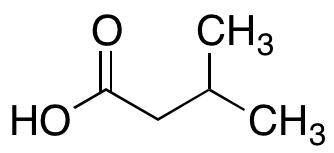
Isovaleric acid
Lanolin
Lanolin refers to the wax secreted by the sebaceous glands of wool-bearing animals. Reminiscent of a dirty/fatty aroma.
- Some sheeps' milk cheeses
Lanolin is made up of long chain fatty acids.

Long chain fatty acids
Hay
Aroma associated with hay or straw. Commonly known as the "Feedy" defect.
- Varies
Unclean practices could cause hay to enter milk supply and flavor could possibly carry over into cheese.
Astringent
Drying or puckering sensation in the mouth.
- Varies wildly
The causes of astringency can vary greatly. In some cases metal ions could give astrigency, in the case of salt-replacing cheese. More information can be found here.
Burn
Prickling or "spicy" feeling in the mouth. Literally feels hot or burning.
- Aged raw milk cheeses
- Lipase cheese
The actual mechanism of the burn sensation is not fully understood. There are several possible explanations. One explanation is the formation of certain alcohol compounds in the cheese that elicit a burning feeling. Another explanation could be histamine formation in the cheese. Lipase effects are also being studied.

Histamine - a possible culprit
Soapy
Aroma associated with soap. Think ivory soap.
- Some goats' milk cheeses
Soapy aroma/flavor is usually caused by medium and long-chain fatty acids.

Long chain fatty acids
Waxy
Aroma associated with wax.
- High fat cheeses
Long-chain fatty acids once again. Heavily saturated.

Long-chain saturated fatty acid
Butyric
Aroma associated with baby vomit. Often called "rancid" or "piquant".
- Provolone
- Lipase cheese
Comes from the fatty acid butyric acid. Lipase cleaves off fatty acids from triglycerides.

Butyric acid
Sulfur
Aroma associated with sulfur, boiled eggs, struck match.
- Some aged cheddars
- Very variable
Sulfur is the hallmark of some aged cheddar cheeses. Sulfur is dervied from sulfur-containing amino acids. Microbial action (or perhaps enzymes) produce sulfur compounds such as: hydrogen sulfide, methyl mercaptan, etc.

Methyl mercaptan
Ammonia
Aroma associated with ammonia.
- Camembert cheeses
- Some smear cheeses
Ammonia and ammonia compounds can be a result from microbial metabolism. For camembert, the mold produces ammonia.

Ammonia (NH3)
Salt
Basic taste
- Various
Flavor enhancer
Bitter
Basic taste
- Various
Often confused with acid
Sweet
Basic taste
- Various
While sugar is rarely added to cheese, sometimes sweet taste is present. In the case of swiss cheese, it is thought the amino acid proline is responsible.

Proline
Acid
Basic taste
- Various
N/A
Umami
Basic taste. Meaty, savory, etc.
- Various
N/A
Chemical
Catch-all term to describe a foreign taste in cheese.
- N/A
N/A
Metallic
Tangy-ness associated with having metal in the mouth.
- Some salt-replacer cheeses
- Excessive acidity
Common in instances where potassium chloride (KCl) is being used to lower sodium contents.
Brothy
Aroma of beef broth. Sometimes referred to as meaty. Similar to umami.
- Various
- Aged cheddar
- Aged Parmesan
N/A
Roasted
Aroma of roasted vegetation and meats. Similar to brothy, but often associated with cooked nuts.
- Various
Roasted aroma is usually attributed to Maillard browning products and their derivatives.
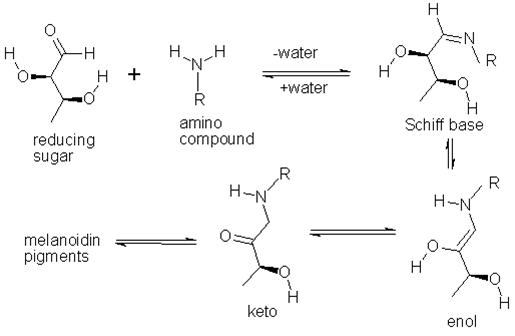
Example of the Maillard reaction
Moldy
Aroma associated with fresh-cut grass. Reminiscent of a pasture or green field. Often times just called by the general term "green".
- Cheese from grass-fed cows
Grassy aroma is usually attributed to aldehyde compounds such as geraniol or hexanal. These compounds usually come about through the secondary oxidation of lipids.

Hexanal - an aldehyde
Musty
Aroma associated with fresh-cut grass. Reminiscent of a pasture or green field. Often times just called by the general term "green".
- Cheese from grass-fed cows
Grassy aroma is usually attributed to aldehyde compounds such as geraniol or hexanal. These compounds usually come about through the secondary oxidation of lipids.

Hexanal - an aldehyde
Yeasty
Aroma associated with fresh-cut grass. Reminiscent of a pasture or green field. Often times just called by the general term "green".
- Cheese from grass-fed cows
Grassy aroma is usually attributed to aldehyde compounds such as geraniol or hexanal. These compounds usually come about through the secondary oxidation of lipids.

Hexanal - an aldehyde
Malty
Aroma associated with fresh-cut grass. Reminiscent of a pasture or green field. Often times just called by the general term "green".
- Cheese from grass-fed cows
Grassy aroma is usually attributed to aldehyde compounds such as geraniol or hexanal. These compounds usually come about through the secondary oxidation of lipids.

Hexanal - an aldehyde
Whey Taint
Aroma associated with fresh-cut grass. Reminiscent of a pasture or green field. Often times just called by the general term "green".
- Cheese from grass-fed cows
Grassy aroma is usually attributed to aldehyde compounds such as geraniol or hexanal. These compounds usually come about through the secondary oxidation of lipids.

Hexanal - an aldehyde
Fermented
Aroma associated with fresh-cut grass. Reminiscent of a pasture or green field. Often times just called by the general term "green".
- Cheese from grass-fed cows
Grassy aroma is usually attributed to aldehyde compounds such as geraniol or hexanal. These compounds usually come about through the secondary oxidation of lipids.

Hexanal - an aldehyde